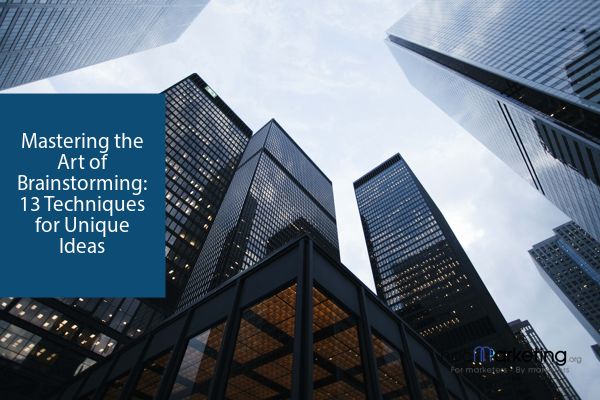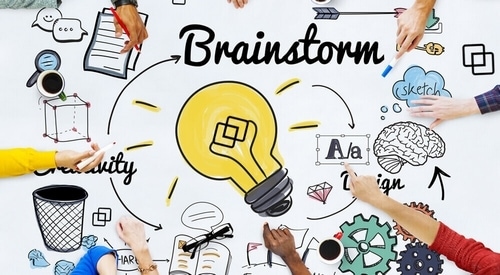
Mastering the Art of Brainstorming: 13 Techniques for Unique Ideas

Brainstorming is an effective technique to generate innovative ideas and solutions It involves a group of individuals who contribute their spontaneous ideas to solve a specific problem There are various types of brainstorming techniques such as Nominal group, Reverse, Speedstorming, Brain Writing, Mind Mapping, Focus Group, Concept Maps, and more Each technique offers a unique approach to generate ideas and fosters creativity
As a group creative technique, brainstorming involves the contribution of spontaneous ideas from its members to solve a specific problem or explore the creative possibilities of a particular topic. The goal of brainstorming is to generate new ideas or solutions from a group of people by removing their inhibitions and encouraging them to think freely. All ideas are noted down during the session, regardless of their practicality, and are evaluated after the brainstorming session.
13 types of Brainstorming
Brainstorming techniques vary depending on the specific needs they aim to address. There are multiple types of brainstorming that can be used to generate ideas and solutions tailored to a particular situation.
1) Nominal group technique
Participants in this brainstorming session contribute their ideas anonymously, with the highest-rated ideas undergoing further evaluation by the group. Subsequently, the group may break down into smaller subgroups to work on specific aspects of a selected idea. After the discussion, the subgroups submit their ideas anonymously once again, and the group collectively rates the new ideas. The process may result in changes, including the reappearance of ideas previously excluded, due to the natural evolution of the discussion.
2) Reverse Brainstorming
Reverse thinking, also known as the barrier method, involves intentionally introducing obstacles in order to find creative solutions and achieve objectives. This technique is especially useful for individuals or groups who struggle with generating ideas or maximizing the potential of existing assets.
To reverse brainstorm, the first step is to identify the problem and then try to prevent the actions that lead to it. By doing so, you can find ways to overcome the barrier or solve the problem. For instance, when creating an advertisement for a deodorant, instead of asking how to make it more appealing, you reverse the question and ask how to make it more unappealing. This approach helps you avoid the wrong actions and find the right ones to take. It's important to follow the common objective of brainstorming, which is to consider all ideas before making a decision. Reverse brainstorming can be more challenging than other methods, which is why it may not be favored by everyone.
3) Speedstorming :
This brainstorming technique involves six individuals who are given a sheet of paper each. Each participant is given five minutes to generate four unique ideas. Once the time is up, the papers are passed to the right, and the next person builds on the ideas presented on the paper they received from their left. This process continues until all the papers have been circulated, and everyone has contributed to each sheet of paper.
4) Content Brainstorming Key :
To maximize creativity and generate a large number of ideas efficiently, Speedstorming is a useful technique. This involves setting a time limit of around 30 minutes and generating as many ideas as possible within that timeframe. By increasing the number of ideas generated per person, the process becomes even more effective. The descending order of participants, time, and ideas adds to the intensity of the brainstorming session.
HubSpot offers a unique, visual approach to content brainstorming that caters to individual thought processes. The centerpiece of this approach is an Excel spreadsheet that helps define the topic, target audience, and recommended content structure, including the format of the post (graphic, audio, or video).
Participants in this brainstorming exercise use these four criteria to generate as many ideas and headlines as possible, resulting in a comprehensive record of potential content. This approach is particularly effective for more in-depth brainstorming sessions with facilitators and participants working together to refine the content structure.
5) Group Passing Technique :
In this collaborative brainstorming technique, each participant generates an idea individually and passes it on to another member in the group. This process is repeated until everyone has contributed to and received feedback on each idea. The final product is then presented to the group for collective evaluation.
6) Question brainstorming :
During this form of brainstorming, the focus is on generating questions rather than ideas. These questions serve as a catalyst for further discussion, as participants naturally begin to answer and build upon them, leading to new and innovative queries. Ultimately, the group identifies and prioritizes the most pressing questions that require immediate attention.
7) Brain Writing
Brainwriting session involves six individuals who are given paper and instructed to jot down as many ideas as possible within a span of five minutes. After the stipulated time, each participant passes their idea to the next person who generates additional ideas on the original suggestion in the next five minutes.
Brain writing and speed storming are two different methods of generating ideas. In brain writing, individuals work on the initial idea to produce a new set of ideas. On the other hand, speed storming involves passing three ideas to the next person who adds three more ideas, and so on. These techniques are useful for generating a large number of ideas in a short amount of time and are particularly suited for exploring broad topics.
8) Mind Mapping
The technique of mind mapping involves creating a diagram to explore and expand upon a specific idea or situation. The process begins by identifying a central word or concept, which is then placed at the center of a board or page. From there, participants generate related categories and ideas, which are connected to the central word through branching lines. By visually connecting these ideas, participants are able to more easily explore and expand upon each concept in relation to the others. Ultimately, the goal of mind mapping is to create a comprehensive web of interconnected ideas, allowing for a more holistic understanding of the subject at hand.
9) Focus Group :
A focus group is a powerful tool used by corporations to gather feedback on their newly launched products or to brainstorm solutions to specific ideas. This approach involves targeting a small group of individuals, carefully selected to represent a diverse range of perspectives and backgrounds. Through this process, companies gain valuable insights into the thoughts, opinions, and preferences of their target demographic, allowing them to make informed decisions and refine their offerings to better meet the needs of their customers. Ultimately, a well-executed focus group can be a game-changer for businesses looking to stay ahead of the competition and succeed in today's rapidly evolving marketplace.
10) Concept Maps :
The success or failure of the focus group method heavily relies on the selection of participants. Participants are provided with a specific topic, idea, or problem to discuss, and their conversation is observed and noted without their knowledge. These observations are then collected and presented in a report.
11) Team idea mapping :
While Mind Mapping and Concept Mapping share similarities, there is a distinction in their usage of language. Mind Mapping uses single words, whereas Concept Mapping utilizes ideas or concepts. Moreover, Concept Mapping entails additional details and subcategories to the information presented on the web, which was previously discussed in Mind Mapping.
11) Team idea mapping :
Participants in team idea mapping are provided with a specific topic and encouraged to brainstorm independently. These ideas are then connected and organized into a map format, grouping similar concepts together. As ideas are shared on a communal board, participants explain their inspiration behind each idea, providing others with insight into the perspective of the respective contributor.
Throughout the discussion, new ideas may arise and be added to the map. Once all ideas have been captured, the group can prioritize them and create a plan of action.
12) Affinity Diagrams :
Affinity diagrams are powerful tools that enable the categorization of information into distinct quadrants, making them a valuable asset in brainstorming sessions and idea creation. As a form of visual brainstorming, affinity diagrams can provide crucial context and help teams see patterns and connections that may not be immediately apparent. With their versatility and ability to organize complex data, affinity diagrams are a must-have tool for any creative team.
Once the ideas are recorded, they are divided into categories and subcategories which leads to expansion of ideas which can then be segregated to form an action plan.
13) Electronic Brainstorming (EBS) :
Incorporating electronic media to brainstorm ideas is called electronic brainstorming, which is especially effective for video conferencing. By using a common network, each team member can contribute ideas or suggestions that can be refined and combined to create a meaningful conclusion. If desired, participants can choose to remain anonymous when using email instead of video conferencing. One of the biggest benefits of electronic brainstorming is the ability to collaborate with individuals in diverse geographic locations while preserving the anonymity of contributors.







